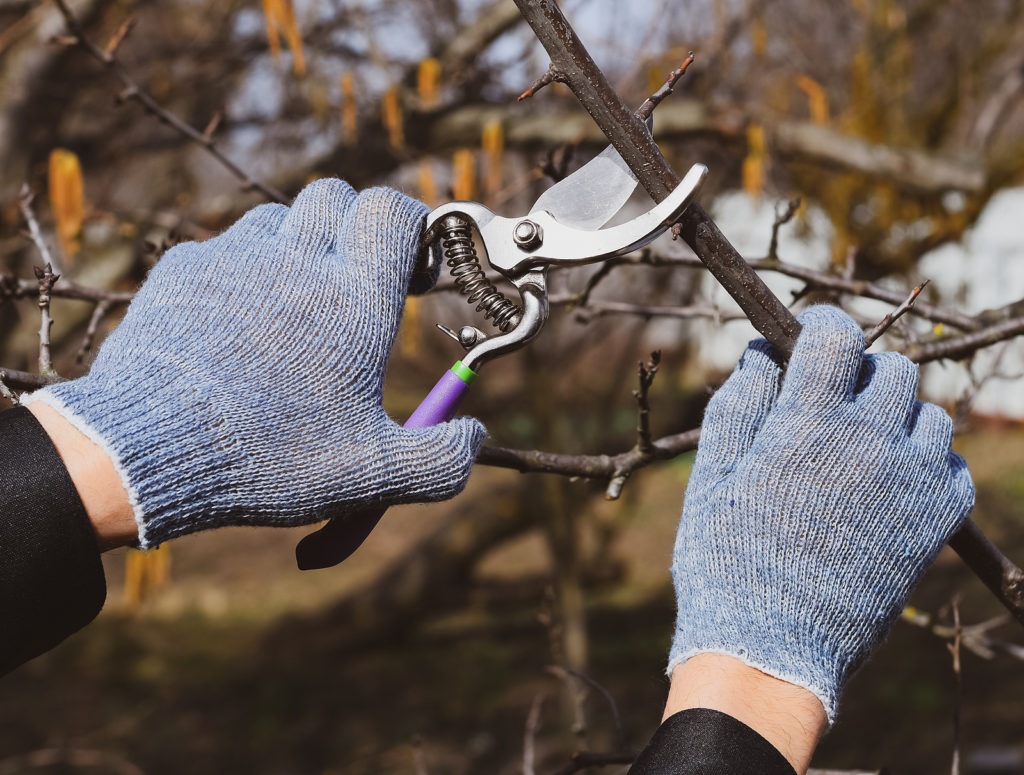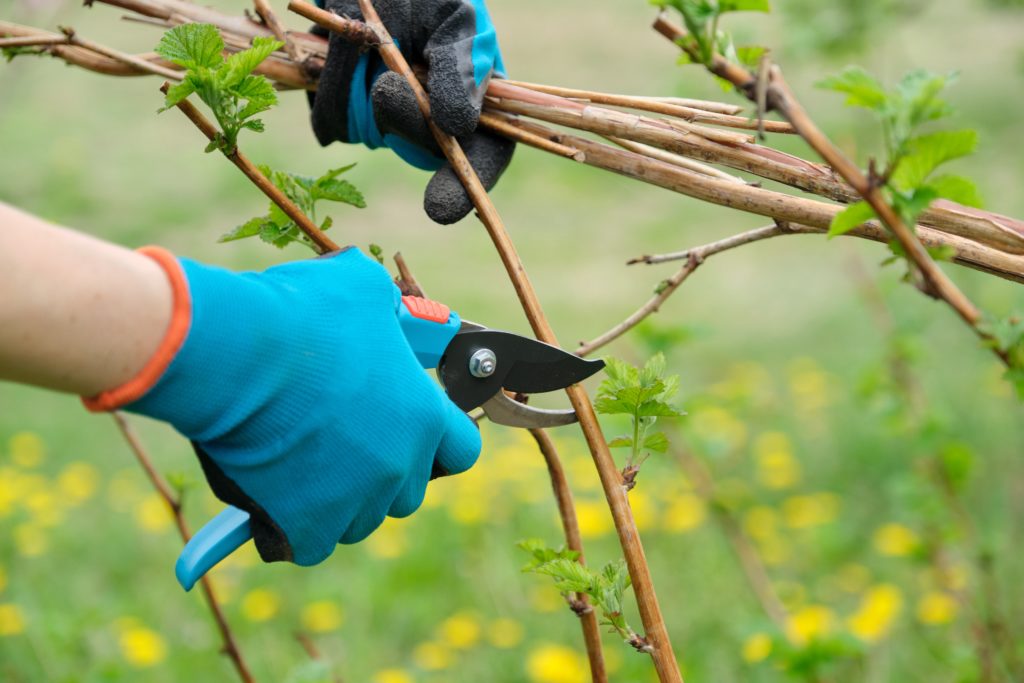Pruning shears or hand-held pruners are used for snipping away live or dead twigs, branches, and stems that are no larger than the diameter of your thumb (about 3/4 inch in diameter). Hand pruners have two blades that come together to cut when the handles are squeezed. Hand pruners are also called secateurs (a French term).
It is important to use the right pruner for the task and to use it correctly to avoid damaging the plant. Bypass prunes are used to cut live plants–small twigs, stems, shoots, and flowers. Anvil pruners are used for cutting dead twigs and branches.
Two types of pruning shears
There are two common types of pruning shears: bypass and anvil. Bypass pruners or scissor-type pruners have two offset cutting blades. They make a close, clean cut and are used to trim live plant tissue. Anvil pruners have one sharpened blade that strikes against a flat, broad plane–the anvil. They tend to crush the plant tissue and so are used to trim dead plant tissue.
Bypass pruners are more widely used and are the choice of most landscape professionals. Bypass pruners are commonly more expensive than anvil pruning shears, but they give you a better, cleaner cut.

How pruners work
A bypass pruner has two curved blades that are sharpened on both sides allowing for the cleanest cut. The thinner blade is the one that slides past the thicker blade. An anvil pruner has one sharpened cutting blade that strikes the anvil. An anvil pruner tends to flatten and crush the stem against the anvil and so is best used on dead wood.
Anvil-type pruners are slightly easier to squeeze than bypass pruning shears, but the anvil prevents the cutting blade from making a close cut, so they tend to leave stubs. Place the pruners so that the anvil is underneath the branch you are cutting. Bypass pruners do not leave stubs; they can be placed close to the place where two branches or stems meet to prune away one from the other with a close, clean cut.
Other kinds of pruners
There are several variations of bypass and anvil pruners:
- Curved bypass shears–also called blade-on-blade, double-cutting, or hook-and-blade shears: have two slightly curved blades that cut when their surfaces pass each other.
- Straight bypass shears–also called grape shears, thinning shears, minishears, or houseplant shearts: these ut like bypass shears, but the blade edges are straight, rather than curved.
- Needle-nose pruners: these are similar to straight bypass shears (above) but are usually smaller with a pointed tip.
- Pocket pruners — some smaller pruners made with short handles are sometimes called pocket pruners; they are made for smaller hands. Pocket pruners often have blunt ends so they can be carried in a pocket.
- Left-handed pruners have one grip that rotates to fit the angle of the hand as it moves through the squeezing motion, reducing friction, fatigue, and the possibility of blisters.
- Left-handed pruners are also available. (Felco brand pruners Models 9 and 10 are left-handed.)
- Long-reach pruners that have extensions with an added lever. Long-reach pruners can be used by wheelchair-bound gardeners.
Use the right pruning shears for the job
Bypass pruners have a sharp cutting blade that moves past a less sharp blade like scissors. Use bypass pruners to cut branches up to 3/4 inch in diameter. Hold bypass pruners with the sharp blade next to the branch to ensure you make a clean, close cut of live tissue that does not leave a stub.
Anvil pruners have one sharp blade that meets a flat plate. Anvil pruners have a lot of cutting power, but they tend to crush stems. Use anvil pruners on dead stems, and dead wood.

Pruning shears use tips
- Do not twist the shear when you have difficulty cutting–you can bend the blades, and they can’t be bent back
- Do not try to cut a branch that is too thick for the shear; you can bend the blades. If you can’t squeeze through the branch with one hand, the branch is too thick–use loppers instead of a pruner.
- Cut at a diagonal to the grain for less resistance.
- Anvil pruners are the best choice for cutting up branches that have already been pruned from the tree or shrub.
- Curved bypass shears give the cleanest and closest cut; they can cut right down to the trunk or branch, leaving no stub.
- Shears with a thumb-operated lock are easier to use as they allow you to lock and holster or pocket the tool between cuts.
Pruning shears maintenance
- Pruning shears work best when the blades are sharp.
- Keep the spring and pivot area oiled.
Pruning shears buying tips
- Choose hand pruners with hardened steel blades with a high carbon content.
- Choose pruners with hardened and tempered edges.
- Choose a pruner with replaceable blades.
- Choose a pruner with a bolt that can be tightened, or a pivot pin that joins the blade.
- Choose a pruner with a latch for secure closing. The latch should be near the blades, not at the end of the handles.
- Choose a pruner that feels comfortable in your hand. There are a wide range of handles, sizes, and weights. Choose a pruner that feels good in your hand.
- Choose a pruner with a brightly colored grip; pruners are one of the most lost tools.
- Purchase a holster for your pruner that can be attached to your belt.
- Choose shears that come apart for sharpening or blade replacement.
- If the branch is greater than 2 inches in diameter, use a lopping shear, not a hand pruner. Lopping shears have a larger blade and handle about 18 inches long. Lopping shear requires two hands to operate.
- The longer and wider the blade, the thicker the limb the shears will cut.
- Ratchet-style shears provide more strength in the cut and require less effort by the gardener. This is important for arthritic gardeners.
- Pruning shears are sold in a variety of grades determined by weight, design, and overall quality; you generally get what you pay for.
Shopping list
- Bypass pruners
- Anvil pruners
More Buyer’s Guides















